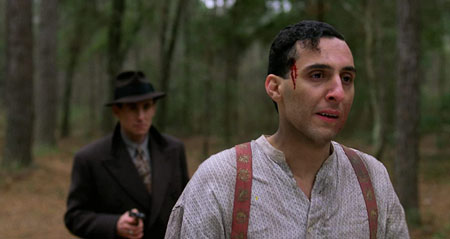
“HAT
TRICKSâ€
By
Raymond Benson
When
Miller’s Crossing was released in 1990, we as an audience were still
trying to determine what the Coen brothers were all about. This, their third
feature film, was totally different from their previous movie, Raising
Arizona (1987), which was radically different from their debut title, Blood
Simple (1984). Raising Arizona was a wacky comedy. Miller’s
Crossing may have had more similarities to Blood Simple, being that
they are both neo-noir crime dramas with a gritty, hard edge but laced
with the now-familiar but then-surprisingly unique ingredient of Coen dark
humor. Still, Miller’s Crossing, being a period piece that takes place
during the Prohibition years, is a more elegant, and certainly more technically
accomplished, picture than Blood Simple. Sudden, brutal violence, though,
remains a trait of both movies.
In
an excellent supplemental interview with Joel and Ethan Coen that appears on
the new Blu-ray release from the Criterion Collection, the brothers discuss noir
influences in both literature and cinema with author/screenwriter Megan
Abbott, and the revelations are both illuminating and hilarious, as one would
expect from these guys. They admit that Miller’s Crossing likely owes
more to the works of Dashiell Hammett than, say, Raymond Chandler or James M.
Cain. They also cite the numerous film noir productions pouring out of
Hollywood in the late 1940s and early 50s as influences, although Crossing eschews
this stark black and white style for gorgeously rendered color cinematography
(by Barry Sonnenfeld) to create a more poetic, art-house rendition of a noir
crime drama.
For
the first half (or so) of the brothers’ career, the Director’s Guild rules
prohibited both names being credited as director, so Joel was usually credited
as director and Ethan was credited as producer, and both were credited as
screenwriters. Now the brothers share all three credits. When they were writing
Miller’s Crossing, they became stuck. The plot is complex, with a hint
of Hammett’s Red Harvest within in that the protagonist, Tom Reagan,
sets out to play two rival mobs against each other. When the writer’s block
became so fierce, the Coens put the script aside and went on to write what would
be their fourth film, Barton Fink, a script they finished in three weeks
(ironically, it’s about a screenwriter with writer’s block). That break allowed
them to come back to Miller’s Crossing afresh, and the screenplay was
completed.
In
viewing the film, one might think it’s about hats. Fedoras, to be precise. Just
about every male character wears one, and Tom, especially, takes great care to
always pick up his hat if it falls off or if he gets hit in the face (which
occurs multiple times during the course of the movie). In fact, the opening
credits focus on a hat on the ground in the forest, and the wind mystically
picks it up and carries it away from us—certainly a metaphor for the era
depicted in the story that is now gone with the wind. Hat tricks.
Tom
Reagan (Gabriel Byrne) is the right-hand man for Irish mob boss Leo O’Bannon
(Albert Finney), who “runs the (unnamed) town.†The mayor and police chief are
in his pocket. Rival Italian mob boss, Johnny Caspar (Jon Polito), desperately
wants to knock Leo off the throne, but his current concern is to bump off
Bernie Bernbaum (John Turturro), a bookie who has been selling information about
Caspar’s fight fixes. Leo won’t allow Caspar to kill Bernie because he's dating
Bernie’s sister, Verna (Marcia Gay Harden). Little does Leo know, but Tom and
Verna are also seeing each other behind his back. Caspar and his goons strike
at Leo, fail in an assassination attempt, but succeed in knocking Leo off his
pedestal. Now Caspar is in charge and the mayor and police chief are in his pocket.
Leo and Tom fall out over the Verna situation, so Tom goes to work for Caspar.
The Bernie problem is still a thing, so to show his loyalty to his new boss,
Tom must reluctantly take out Bernie. To reveal more would spoil the twists and
turns the tale takes.
The
cast, especially Finney and Harden, are excellent. Jon Polito and John
Turturro, however, steal the film with over-the-top performances that are
Kubrickian in nature. Steve Buscemi makes his first appearance in a Coen brothers’
picture in a small but memorable fast-talking scene. Look for Frances
McDormand, making a cameo as the mayor’s secretary, as well as Coen brothers
friend Sam Raimi as a gunman.

Carter
Burwell’s music is a counterpoint to the action. Burwell had the idea to
develop a plaintive, melodic Irish folk tune as the theme; the Coens at first
weren’t sure about that, but once they heard it, they agreed it was the way to
go.
All
of that said, this reviewer finds Miller’s Crossing to be a good, but
not great, entry in the Coen brothers’ canon. The overly complicated plot is a
little difficult to follow without repeated viewings. It’s also a challenge to
empathize with Tom Reagan, which may be due to actor Byrne, who elicits little
warmth in the role. Nevertheless, the picture creates a mood and visual beauty
that are striking.
The
Criterion Collection’s new 2K digital restoration, approved by Sonnenfeld and
the Coens, looks marvelous. It comes with a 5.1 surround soundtrack mix,
presented in DTS-HD Master Audio. There are English subtitles for the hearing
impaired.
There
are wonderful supplements on the disk. The aforementioned interview with the
Coens is priceless. There are also new interviews with Gabriel Byrne and John
Turturro, Carter Burwell and music editor Todd Kasow, Sonnenfeld, production
designer Dennis Gassner, and vintage featurette interviews from 1990 with the
cast. The booklet contains an essay by film critic Glenn Kenny.
Miller’s
Crossing is
for fans of the Coen brothers, certainly, as well as cast members Byrne,
Finney, Harden, and Turturro. And if you’re an aficionado of mobster
flicks—period or modern—then Miller’s Crossing is the hat trick for you.
CLICK HERE TO ORDER FROM AMAZON